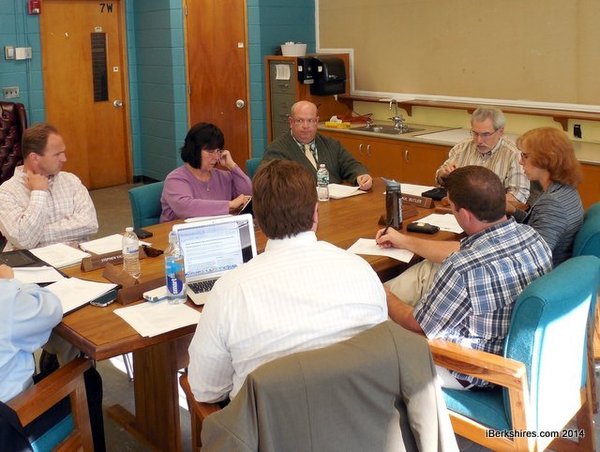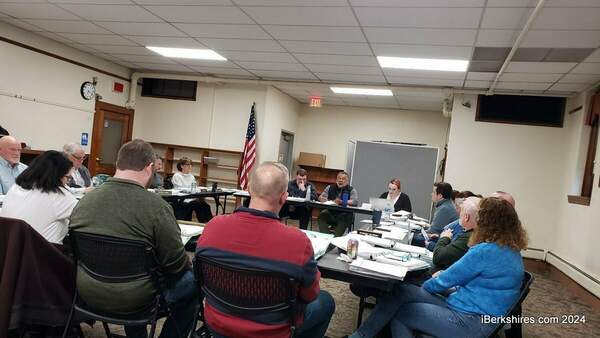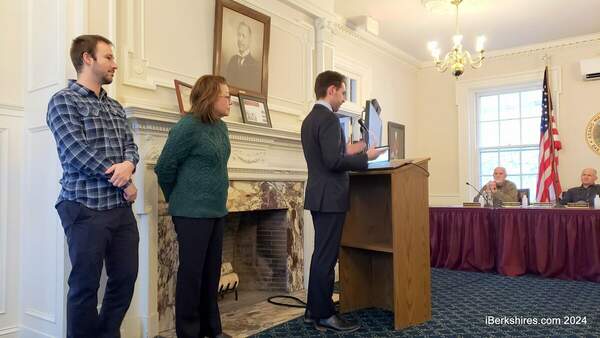
Adams-Cheshire Prepped for Layoffs, Bogged Down by Evaluations
.jpg) The School Committee heard about preparations for staff cuts and the difficulties administrators are having with mandated teacher evaluations. The School Committee heard about preparations for staff cuts and the difficulties administrators are having with mandated teacher evaluations. |
ADAMS, Mass. — Employees in the Adams-Ceshire Regional School District are being prepared for layoffs to close the district's $300,000 budget gap.
Cheshire Elementary Principal Peter Bachli reviewed the process at the School Committee's meeting earlier this week. Superintendent Kristin Gordon was unable to attend the meeting,
Bachlisaid all first-year paraprofessionals have been informed as well as a science teacher and a librarian at Hoosac Valley High School. An empty elective position left by a retirement will not be filled.
C.T. Plunkett Elementary will not replace the retirements of two Title 1 reading teachers and one classroom teacher.
Cheshire Elementary School will eliminate a teacher position that was supposed to be filled. This leaves 29 pupils that must be displaced into other class rooms.
The school district was forced to cut nearly a half-million from the fiscal 2015 budget, including staff positions. Adams town officials have expressed concern over the cuts but raising Adams' share of the budget would require Cheshire to the same, and there's no indication Cheshire would approve doing so.
The committee on Monday also was told on Monday that the state-mandated teacher evaluations are becoming a burden.
The subject came up when the principals from the three schools presented their school improvement goals for the 2014-2015 school year.
Plunkett Principal Michelle Colvin said teachers must compile large artifact binders that contain elements of their curriculum. It is up to the principal to observe the binder and perform observations.
"I am doing eight teachers this year which feels like a full-time job," Colvin said.
Colvin said she has to evaluate four sections for six different grade levels as well as extracurricular teachers. Without other administrators who are not on a teacher contract, Colvin has to evaluate all of the teachers on her own.
"It's kind of a sticky point, but we are working on it," she said.
Colvin and Gordon have been working on creating a better process. Colvin suggested bringing administrators from other schools in the district, but felt this would be unfair to those schools and to the teachers who would prefer to be evaluated by their own supervisors.
"We can't be pulling resources from other schools," Colvin said. "They are just as busy as we are down in our building."
Bachli agreed with Colvin and said the teacher evaluations take too much time. Without a dean of students, Bachli has little time to evaluate because he must deal with students with behavioral issues.
"My situation is that I don't have a dean of students or someone for discipline," Bachli said. "If I have a kid in my office for discipline, I am locked in so that becomes a difficulty."
Bachli, a member of the board of the Massachusetts Elementary School Principals Association, said other teachers are having similar difficulties with the state-mandated evaluations.
"All principals are going through this same thing, and it really is so labor intensive and people say they can't keep up with it," he said. "There is a big wave currently of people saying that they can’t keep up with these artifact binders."
Hoosac Valley Principal Vince Regan said he, too, finds the teacher evaluation process very difficult even though Hoosac Valley has three administrators who can evaluate teachers. He said there is software that helps streamline the process, but the district does not have the money in the budget to implement the program.
"There is software where you can do this and update it in a matter of minutes," Regan said.
Committee member Joshua Demarsico-Birkland added that the teacher evaluation system has changed the way administrators do their jobs.
"This teacher evaluation system really changed what the administrator's job needs to be, but there is no funding to support it," Demarsico-Birkland said.
The committee made a preliminary decision to report to the Department of Education that the district will partake in the Massachusetts Comprehensive Assessment System test instead of the new PARCC test next year. The PARCC, or Partnership for Assessment of Readiness for College and Careers, is being piloted in a number of districts but the state has yet to commit to it.
"Just from the field testing of the PARCC there were too many flaws and too many variables," Bachli said. "I guess it is sort of a better the devil you know than the devil you don't know kind of situation."
Bachli also informed the board that the water in Cheshire Elementary School is now safe to drink.
"I just got word today that everything came back fine and we are all set to resume normal use," he said.
Last week there were complaints of a petroleum type scent in the water. The school immediately shut off the water and relied on bottled water to drink, wash, and cook with.
The water commission tested the water and said it was safe and said that the smell may have come from a loose fitting adjustment that was leaking grease into the water.
Tags: ACRSD, layoffs, PARCC, teaching,















